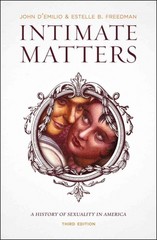
D’Emilio, John and Estelle B. Freedman. Intimate Matters: A History of Sexuality in America. Third Edition. Chicago: University of Chicago Press, 2012.
Subject: An overview of the history of sexuality in North America from 1600 to the present.
Main Points: The authors have put together this well-written synthesis of the history of American sexuality from the colonial period to the present (two more chapters have been added in this third edition to bring the story up to the early twenty-first century). The book is full of information, based on both original research and secondary literature, and as such, it can be used as a great textbook for a history of sexuality class. Beyond providing excellent information, the authors set up an interpretive framework that primarily challenges the notion of a Whiggish trajectory of continual sexual liberation and progress. In fact, freedom and repression actually play small roles in the authors’ story.
The main argument is that “over the last three and a half centuries, the meaning and place of sexuality in American life have changed: from a family-centered, reproductive sexual system in the colonial era; to a romantic, intimate, yet conflicted sexuality in the nineteenth-century marriage; to a commercialized sexuality in the modern period, when sexual relations were expected to provide personal identity and individual happiness, apart from reproduction” (x-xi).
Throughout the book, the authors are dealing with three main questions or topics. First, they wish to show that notions of gender and sexuality are socially constructed, and thus historically specific. The changing nature of the economy, the family, and politics has shaped sexuality throughout American history. They also go further to show that sexual relations are a significant source of inequality between men and women. They also focus on how sexual discourses also helped shape understandings of class and race. Blacks were portrayed as sexually depraved beings, while the working class was understood as immoral and weak.
The second concern of the book is to show how systems of sexual regulations have changed. “By sexual regulation, we mean the way a society channels sexuality into acceptable social institutions” (xv). Here, they study authority: who has the power to determine what is normal or deviant (doctors, legislators, clergy)? How are these mores enforced? In early America, “a unitary system of sexual regulation that involved family, church and state rested upon a consensus about the primacy of familial, reproductive sexuality” (xvi). Deviants could be punished through the law or even publically humiliated until they repented. By the late eighteenth to the late nineteenth century, the role of the state and church in sexual regulation diminished as commercialization and industrialization created more emphasis on individuals. Women (as keepers of homes and morality) were meant to create self-regulating sexual beings. Reproduction became less important as a legitimizing factor as sex became seen as a source of romance and intimacy for married couples. The focus on individuals led to the greater acceptance of deviant forms of sexuality (like same-sex intimacy), though they always remained marginalized. The media were saturated with “sexual images that promise free choice, but in fact, channel individuals toward particular visions of sexual happiness, often closely linked to the purchase of consumer products” (xvi). So, by the 1880s, the beginning of a more liberal sexuality was starting to emerge, though sexuality became more and more commercialized.
But by the end of the nineteenth century, moral and purity reform groups attacked these new expressions of sexuality, passing anti-abortion, anti-pornography, and anti-prostitution legislation. In other words, the state was expected to take a greater role in regulating sexuality. Between the 1920s and 1960s, the liberal model of sexuality became more dominant until the 1970s witnessed a radical challenge to the norm by the radical Left, calling for more sexual freedom and the end to hetero-normative marriage (more personal freedom, less state control). Beginning in the 1980s, there was a conservative backlash that gained momentum as AIDS was portrayed as symptomatic of America’s moral breakdown.
The third concern of the book, sexual politics, is related to sexual regulation. Rather than looking at the structures of power, the notion of sexual politics focuses more closely on the struggle among different groups over a given sexual order (i.e., the competition to reshape the dominant sexual meaning or impose standards of morality). The authors identity three critical patterns that recur in the history of sexual politics in America: 1) “political movements that attempt to change sexual ideas and practices seem to flourish when an older system is in disarray and a new one forming; 2) there is a consistent relationship to inequalities of gender and sexual politics. “Even more than its relationship to class and race, sexual politics arise from efforts of male authorities to define female sexuality and of women either to resist such definitions or to counter through efforts to reshape sexual values and practices; 3) the politics of sexuality responds to both real and symbolic issues, meaning that while “real” things such as abortion, disease prevention, and marriage are affected by sexual politics, these debates are often symbolic for larger issues like impurity and disorder.
My Comments: I’ll definitely be using this as a textbook when I end up teaching my own class. I’m looking forward to being able to go back and read it more thoroughly, but the framework for the synthesis is convincing and enlightening. They take care to (in the Intro and throughout) explain their arguments carefully without academic jargon. The third edition also ends with a really helpful historiographical essay that summarizes the state of the field.
For more books on the history of sexuality and gender, see my full list of book reviews here.







